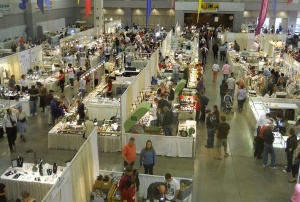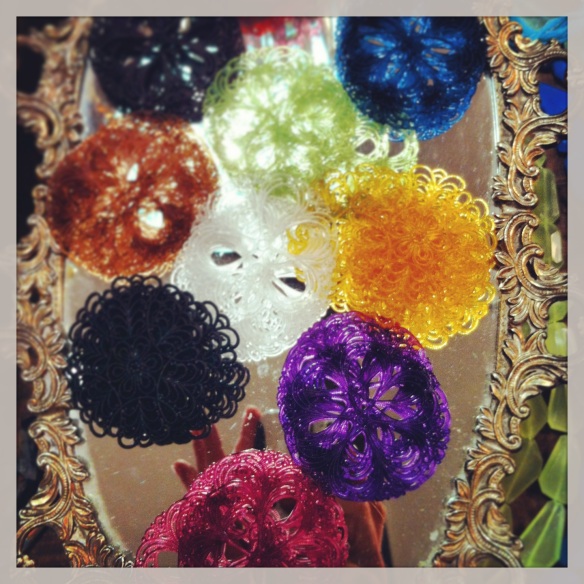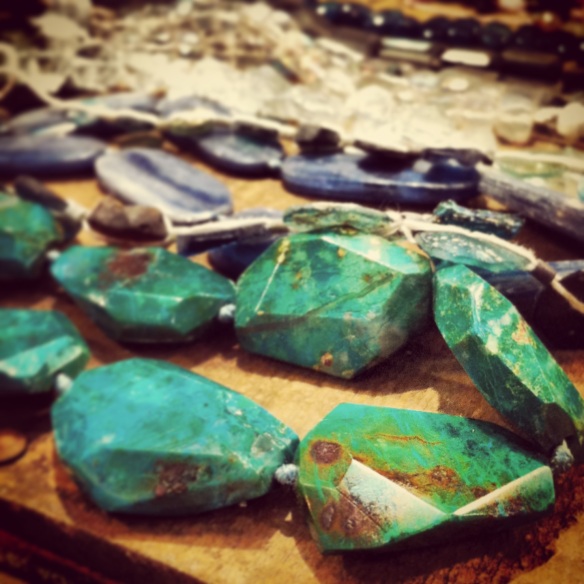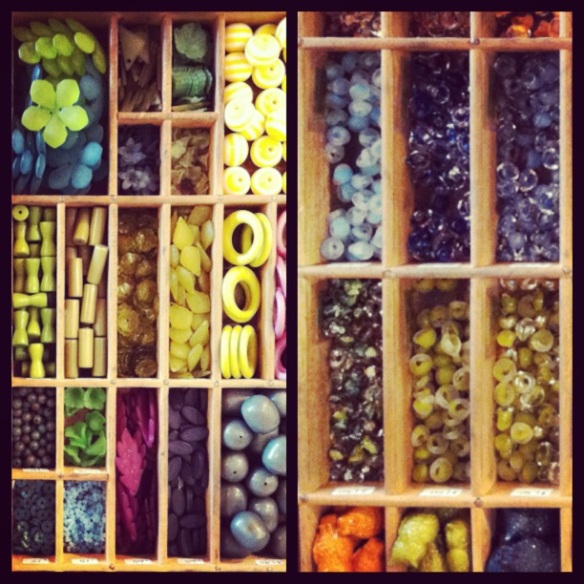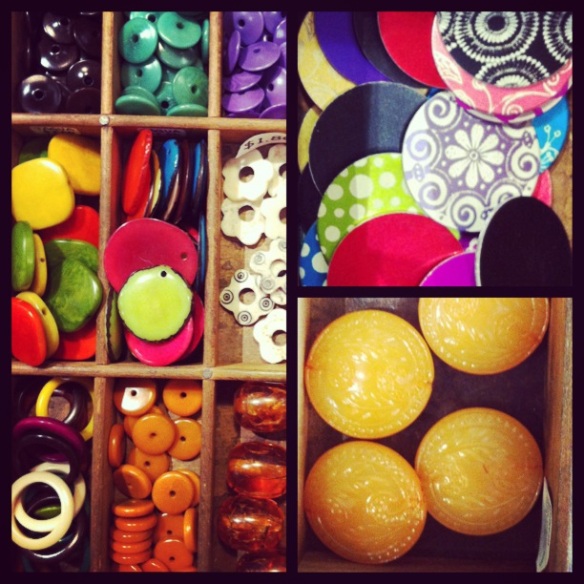At Blue Door Beads, we consider it our duty to be as accurate as possible when helping customers determine what their beaded jewelry is made of. This covers everything from ensuring our vendors are reputable, to labeling our loose beads and bead strands correctly, to being able to give our best guesses when customers bring unidentified beads into the shop from their personal collection.

Is a Herkimer diamond really a diamond? Read more to find out!
Sometimes, when we truly aren’t sure what type of bead we have in our hands, we simply have to admit we don’t know. The most disappointing of circumstances, however, are times when it turns out that we thought we DID identify a type of bead correctly, but we we wrong. We know that everyone makes mistakes, and fortunately we have only been wrong a handful of times in our nearly 4 years in business — out of over 45,000 total sales, that’s not a bad record. Our point is, nobody is perfect. But we want to make sure that YOUR track record for identifying beads is as close to perfect as possible!
There are a few common culprits we’ve come across in our years of being rock hounds and bead aficionadas, and we want to share our knowledge with all of you out there who want to make sure that your beloved jewelry includes beads that are the real deal. Below are a few of the most common phony-baloney beads being peddled on the market. Buyer, beware!
1.) “Fruity” Quartz, such as Cherry Quartz, Watermelon Quartz, and Pineapple Quartz
“Quartz” is a common (and legitimate) descriptor in the bead industry, and although real quartz is prevalent in all areas of the world and there are many different types, disreputable vendors use “quartz” as kind of a catch-all description for any material that is mostly clear or translucent. Chances are, if you have ever been to the beading isle of a generic craft store (we won’t name names), you have come across a pretty, often cloudy, pinkish material called cherry quartz. It looks like this:
 What a generic craft store sometimes won’t put on their packaging is that cherry quartz is “a synthetic stone made of hardened glass.” (FusionBeads). Some cherry quartz specimens can be very convincingly gemstone-like, but if you look close enough at most items labeled as cherry quartz, you will see tiny bubbles:
What a generic craft store sometimes won’t put on their packaging is that cherry quartz is “a synthetic stone made of hardened glass.” (FusionBeads). Some cherry quartz specimens can be very convincingly gemstone-like, but if you look close enough at most items labeled as cherry quartz, you will see tiny bubbles:

Natural quartz stones will often have small inclusions present, but they should look like the veins in the beads pictured below, not bubbles:
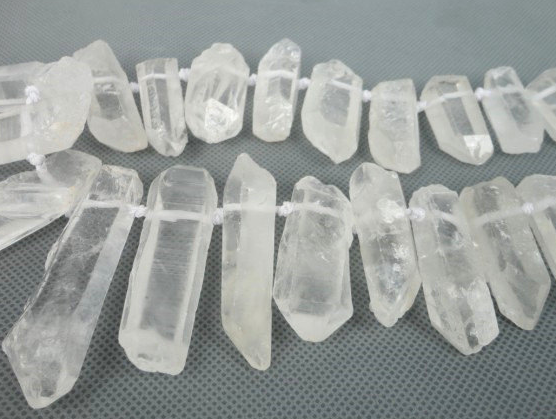 There are some folks out there who will try to convince you that cherry quartz is a natural material, but “since Mother Nature didn’t make this glass the way she did with obsidian from volcanic activity, that means it’s man-made.” (CrystalsAndJewelry.com) Pineapple quartz looks very similar to cherry quartz in terms of the frequency of the inclusions & bubbles present, but it’s a pale yellow rather than pink.
There are some folks out there who will try to convince you that cherry quartz is a natural material, but “since Mother Nature didn’t make this glass the way she did with obsidian from volcanic activity, that means it’s man-made.” (CrystalsAndJewelry.com) Pineapple quartz looks very similar to cherry quartz in terms of the frequency of the inclusions & bubbles present, but it’s a pale yellow rather than pink.
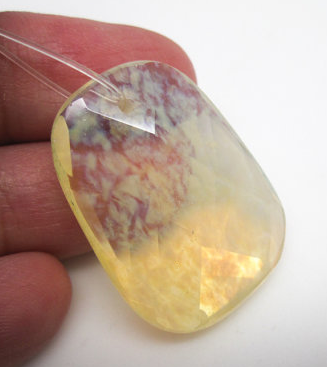 There are a couple of quartz variations with fruit-based names that are not completely man-made, but (chances are) they have been manipulated in some way. For example, lemon quartz can be one of two stones; it starts out either as a natural, light amethyst that is heated with another quartz & iron at extremely high temperatures (Fire Mountain Gems) or it starts as a clear quartz that is “irradiated to produce an intensely-colored yellow gemstone.” (Google)
There are a couple of quartz variations with fruit-based names that are not completely man-made, but (chances are) they have been manipulated in some way. For example, lemon quartz can be one of two stones; it starts out either as a natural, light amethyst that is heated with another quartz & iron at extremely high temperatures (Fire Mountain Gems) or it starts as a clear quartz that is “irradiated to produce an intensely-colored yellow gemstone.” (Google)

Brilliant yellow lemon quartz briolette beads.
One “fruity” quartz that is actually natural is strawberry quartz — a sagenitic quartz that is transparent & colourless, but contains needlelike crystals. In the case of strawberry quartz, those “needles” are red inclusions of iron oxide. The bright color of genuine strawberry quartz is accentuated by small seedlike inclusions of lepidocrocite and haematite. It is most often found in Russia, Kazakhstan, and Brazil. (TheSilverForge)

A beautiful specimen of natural strawberry quartz.
2.) Hydro Quartz
The production of hydrothermal quartz (“hydro” quartz for short) through hydrothermic synthesis is a process with roots in the World War II efforts. According to YourGemologist.com, “quartz crystals were necessary for production of radio and other electronics during the war. [At the time] only high-quality crystals from Brazil were [used] for the high tech production. And since the routes to the Brazilian fields were blocked to German scientists, it was the Germans who perfected the process during the war, [with manmade quartz stones soon taking the] place of the unavailable natural stones.” (YourGemologist)

When you see “quartz” beads in brilliant hues not typically found in nature — and they’re very inexpensive — what you’re holding is hydro quartz.
Apparently, some examples of hydrothermal gemstones feature “long formations of parallel lines…that occur in many hydrothermal gemstones that will allow you to identify…the hydrothermal family of synthetics.” Some gemstones are more likely to have obvious lines that others, and you can find out more about them here: YourGemologist
Typically the easiest way for a consumer to identify synthetic quartz is by size, color and clarity. You will often see synthetic amethyst or citrine in extraordinarily large sizes with perfect clarity. A 20mm stone in a brilliant hue for only $2.50? Definitely synthetic. Natural amethyst or citrine will typically exhibit blocks of color, and even the colors blending together in ways you won’t find in the synthetic versions. Synthetic ametrine, however, “is often found in colors that you won’t see in nature; either the color is extraordinarily vivid, or you will find hues such as blue and green that do not occur naturally.” (GemSelect)

Tumbled natural ametrine.
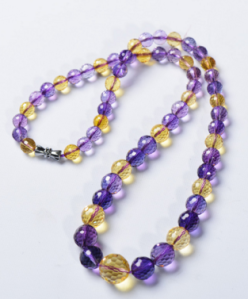
Synthetic ametrine — no color variation within individual beads, and the “amethyst” element is vibrant purple, while the “citrine” element is electric yellow.
One gem hound blogger we came across had a special hatred for the name “hydro quartz,” primarily because she feels “hydro quartz manufacturers came up with the name in order to confuse” consumers. “It sounds a lot like ‘enhydro quartz’ which is a real quartz stone with naturally encapsulated water bubbles inside.” Although it’s unlikely many casual beaders have heard of enhydro quartz and are, therefore, unlikely to think that’s what they are getting with hydro quartz, our best advice is to just assume nothing labeled hydro quartz (or emerald quartz, tanzanite quartz, etc.) is anything other than 100% manmade material. (InVogueJewelry)
3.) Opalite
Opalite is one of the few synthetic stones out there that is often mistaken for two different natural stones: moonstone and opal. Obviously, it is neither; opalite is simply an opalescent glass, similar to “milk glass,” which was first produced in 16th century Venice and enjoyed a resurgence in popularity worldwide during the 1950s and 1960s. Like “milk glass”, opalite is made “by melting opacifiers (such as Titanium Dioxide, bone ash, even cyanide!) with the molten glass.” (InVogueJewelry)

The classic blue iridescence of opalite.
Opalite is sometimes mistaken for rainbow moonstone, which has beautiful blue, iridescent flashes. Moonstone, however, often has many inclusions and variety in its flashes. Opalite is generally flawless, but it may occasionally contain air bubbles from the manufacturing process.
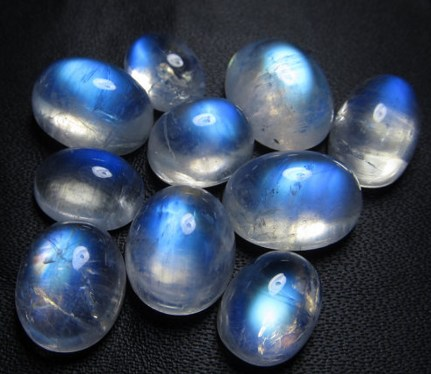
Natural moonstone cabochons.
Sometimes Opalite is sold as imitation opal, but it does not show the distinctive play of color of genuine opal, or even high-quality imitation opal. Imitation opal typically has an orderly and regular pattern to its flashes of color; opalite won’t have any flashes at all, just a bluish iridescence. (JewelledWeb)
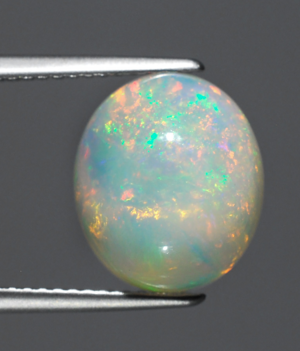
A gorgeous, genuine opal with irregular flashes of brilliant colors!
4.) Herkimer Diamonds
Although these sparkling beauties are lovely, “diamond” is definitely a misnomer. Herkimer diamonds are not actually diamonds, but are “double-terminated quartz crystals of exceptional clarity (water-clear)” discovered in and around Herkimer County, New York. (Wikipedia) True, Herkimers are small, clear, hard, and somewhat rare, considering they are only found in Herkimer County. However, their mineral make-up is 100% quartz. If you ever see a Herkimer diamond being sold for thousands of dollars because it’s “real diamond,” don’t be fooled!
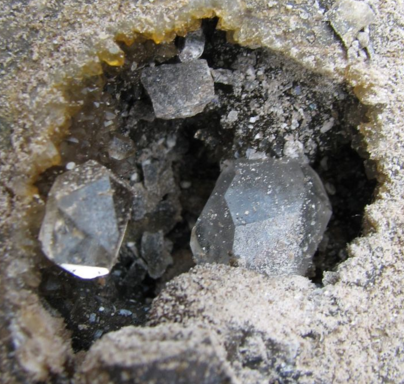
Herkimer diamonds in their natural habitat.
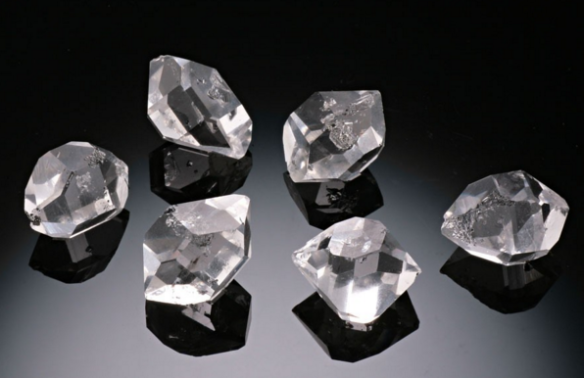
These Herkimer diamonds are classified as BB. Not as crystal-clear as some, but more affordable than AA.
5. Mystic Topaz
Although you can find gemstone sellers who claim that mystic topaz is a “newly discovered” gemstone from the past couple of decades, mystic topaz was never “discovered” — it was created. It is actually a natural colorless (white) topaz “that has been coated, giving it a unique rainbow color effect.” Therefore, it is not a unique type of topaz, but actually an enhanced clear topaz. “The coating technology, known as thin film deposition, was pioneered by a company called Azotic Coating Inc.” The coating usually includes vibrant shades of green, blue, and purple, and although beautiful, it is not a permanent enhancement, so be careful not to scratch it! (GemSelect)
Our advice to you…
Technically, the only way to prove beyond a reasonable doubt that a certain gemstone is genuine is to take it to someone who is professionally trained to identify gems, such as a fine jeweler or a lapidary. For the rest of us average citizens, one of the best rules of thumb you can use is to ask yourself, “Is this price too good to be true?” If so, what you’re buying is probably not the real deal. There’s nothing wrong with imitation stones, provided they are labeled as such. However, do keep in mind that stones that have been heat-treated and/or enhanced in other ways are much more likely to change appearances if they are exposed to what we call “non-normal jewelry conditions”:
* Extreme heat. Examples include leaving jewelry in the glove compartment of your car, or wearing jewelry during a trip to the sauna.
* Direct sunlight. If you keep your jewelry displayed on a dresser or nightstand, keep it out of the blazing afternoon sun.
* Other environments not suited for jewelry. Inappropriate environments include:
– Your gym’s pool. Chlorine can change even the appearance of natural gems, especially if they’re porous.
– The ocean. If boats, ships, and cars stored near the ocean get rusty from salt exposure, imagine how your jewelry feels! Natural and imitation gems will both suffer.
– Your garden. Soil with a high acid level, as well as all kinds of fertilizers, can affect the appearance of your jewelry, so refrain from wearing pieces while gardening.
– Your daily workout. Not only does sweat contain trace levels of salt, but different peoples’ skin produce different levels of ammonia, so an extremely sweaty exercise session could be incredible corrosive to your favorite jewelry, whether it’s made with real gemstones or not.
– Your shower. You know how your tub and shower walls end up with nasty soap scum build-up? Imagine that on your favorite jewelry. Gross! No gem, real or not, should be exposed to that.
In closing, we recommend being both inquisitive and careful when either shopping for gemstones or wearing them. In the end, as long as your piece of jewelry makes you happy, it shouldn’t matter what it’s made off. But for those looking for more information to help them learn more about their jewelry, we hope this post has helped!
Both cherry quartz photos courtesy of FusionBeads.com
Photo of quartz point beads courtesy of Google Images (origin unknown)
Pineapple quartz photo courtesy of loveofjewelry on Etsy
Lemon quartz photo courtesy of TheBeadTraders.com
Strawberry quartz photo courtesy of GemSelect.com
Green hydroquartz briolette photo courtesy of InVogueJewelry.blogspot.com
Natural ametrine photo courtesy of InfiniteFlame.com
Synthetic ametrine photo courtesy of AliExpress.com
Opal photo courtesy of InVogueJewelry.blogspot.com
Rainbow moonstone photo courtesy of Artfire.com
Genuine Opal photo courtesy of DWsCustomerJewelry.com
Herkimer mine photo found on Pinterest, source unknown
All loose herkimer diamond photos courtesy of DavesRockShop.com

